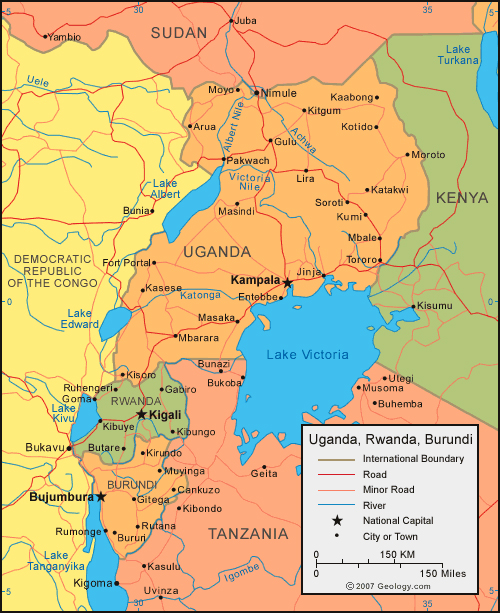
Shake Hands with the Devil (2007)
Director: Roger Spottiswoode
Actors: Roy Dupuis, Owen Sejake, James Gallanders
Runtime: 112 min
General Roméo Dallaire was the Force Commander of the UN peacekeeping force in Rwanda (UNAMIR) in the moment when, at the beginning of April 1994, the Rwandan army and paramilitary forces of the ruling party MRND began a bloody genocide against the minority Tutsi population in which more than 800,000 people lost their lives over a 100 day period. It is believed that about 32,000 people were saved due to the activities of General Dellaire and a small number of UN troops under his command.
However, the issue of Rwandan Genocide is very complex, and to understand what, how and why it happened it is necessary to provide a more detailed socio-historical context. My recommendation is to set this extraordinary film to download and in the meantime read this text before watching the movie.
Let’s start from the beginning. The population of the Kingdom of Rwanda, which existed from the 11th century until 1962, was divided into two socio-economic classes – members of the upper class were called Tutsi and members of the lower classes were Hutu. During the second half of the 19th century, there ware changes in social structure, including a feudal redistribution of farmland and the centralization of power in the hands of the king. The kingdom expands, and all conquered tribes are named Hutu, however every Hutu could become Tutsi by accumulation of wealth and their rise on the social ladder. In the last decade of the 19th century Germany colonized Rwanda and neighboring kingdom of Burundi that had the same social structure. German settlers considered Hutus and Tutsis different races and supported the Tutsi government over Hutus, but didn’t seriously interfere with the social structure. This changes after 1916, when during the First World War troops from the Belgian Congo occupied German territory of Ruanda-Urundi. The Belgians also relied on the existing power structures and domination of Tutsis, but introduced reforms in education, infrastructure, agriculture, while favouring the power and privilege of the Tutsis, which further increased the tension between Hutus and Tutsis. Also, under the influence of quasi-scientific theory of eugenics, Belgian scientists measured the size of peoples skulls, sorted them by height, width of their nose and lightness of skin in order to “scientifically” prove the genetic superiority of the Tutsis. The issuing of identification documents that contained “ethnic” origin began in 1931 and by 1935 whole population had identity cards that stated whether they are Hutu, Tutsi, Twa or naturalized. Education was entrusted to the Roman Catholic Church, which established separate educational systems for Hutus and Tutsis, although during the 1940s and 1950s, access to education was mostly limited to Tutsis, who in the meantime came to believe in the myth of their racial superiority and widely exploited the majority Hutu population.
After the Second World War, this territory became a United Nations trust territory under control of Belgium. Gradual democratization, which included the abolition of certain forms of domination, universal suffrage, agrarian reform, redistribution of pastures etc, encountered resistance by Tutsi traditionalists. The Roman Catholic Church in the region, which used to be one of the strongest advocates of the Tutsi domination, began to support equality in the 1950s, after the military defeat of fascism in World War II and the arrival of young missionaries from Europe originating from the working classes. At the same time, under the influence of anti-colonial ideas of equality, socialism and pan-African unity, occurs a movement for the emancipation of Hutus to whom were opposed Belgian colonists, local UN administration and the ruling Tutsi élite. Soon Hutus and Tutsis established their political parties, which quickly formed their para-military wings. The tension rose through occasional minor clashes and escalated in the Rwandan revolution (1959-1961) in which between 20,000 and 100,000 Tutsis were killed and many fled to neighboring countries. The monarchy was abolished and a Hutu republic established. Over the following years political instability continued and lead to a military coup in 1973, and an establishement of a one-party state in 1978, which lasts until 1990. Meanwhile, after independence in 1962, the second part of the former Belgian territory of Ruanda-Urundi, became the parliamentary monarchy of Burundi, where the Tutsis ruled over the mostly Hutu population. Here occasional conflicts and lasting turmoil lead to the Burundian Genocide in 1972, when the army killed 200,000 Hutus, with many more refugees. The situation at the beginning of the 1980s was this: with many victims on both sides and hundreds of thousands of refugees the Hutus ruled Rwanda and the Tutsis ruled Burundi.
The multi-party system is introduced in early 1990s in order to solve problems through the democratic process, but the frozen conflict breaks out again due to the economic crisis and food shortages. In late 1990, Rwandan refugees, mostly Tutsis, organized in the Rwandan Patriotic Front (RPF), launched an offensive against Rwanda from their bases in neighboring Uganda, with the aim to put pressure on the government of Rwanda to make concessions and to speed up the process of democratization. The Rwandan army was in retreat, but managed to stop the RPF offensive with the help of élite units from Zaire (now DR Congo) and the French paratroopers. Likewise France delivered Rwanda a large quantity of weapons, ammunition and other military equipment. With heavy losses RPF retreated to the mountains on the border of Rwanda, Uganda and Zaire. After regrouping RPF launched a guerrilla war, and hostilities continued over the next two and a half years, until the truce was signed in 1992. Although the intent of the RPF was speeding up democratization, the results were just the opposite. The tension in the country rose to the highest level ever. The propaganda of the ruling party was proclaiming that Tutsi rebels want to re-introduce the feudal system, the Hutu paramilitary organizations carried out intimidation and violence against Tutsis, and the highest circles of Hutu government and the army began to prepare plans for total genocide of the Tutsis, but also for the systematic liquidation of moderate Hutus.
When, on the 6 April 1994, during a landing at the airport in Kigali, unknown persons rocketed the plane in which were the presidents of Rwanda and Burundi, all hell broke out. The Presidential Guard started and the ruling party and paramilitary forces continued the Rwandan Genocide in which during 100 days, mainly with machetes and other cold weapons, was killed between 800,000 and 1,000,000 Tutsis, over three-quarters of all Tutsis in Rwanda. The genocide was stopped in July, when RPF forces occupied the whole country.
The United Nations Mission in Rwanda from the beginning (October 1993) had very limited authority that was restricted to controlling the implementation of the peace agreement and ceasefire monitoring. When the genocide began they weren’t allowed to interfere, and their requests for reinforcements were rejected. Although France, Belgium and the United States had a military units in neighboring countries, they decided only to evacuate foreigners from Rwanda, and as the genocide unfolded they all turned their heads the other way. Moreover, the U.S. and British administrations systematically avoided the use of the word “genocide”, and in the midst of it most UN forces were withdrawn, the original contingent of 2,500 soldiers was reduced to less than 270, who despite everything managed to somehow save around 32,000 people from certain death.
If you have trouble orienting in all this, maybe a map of this small region in East Africa will help:

You can download this film or watch it online.

